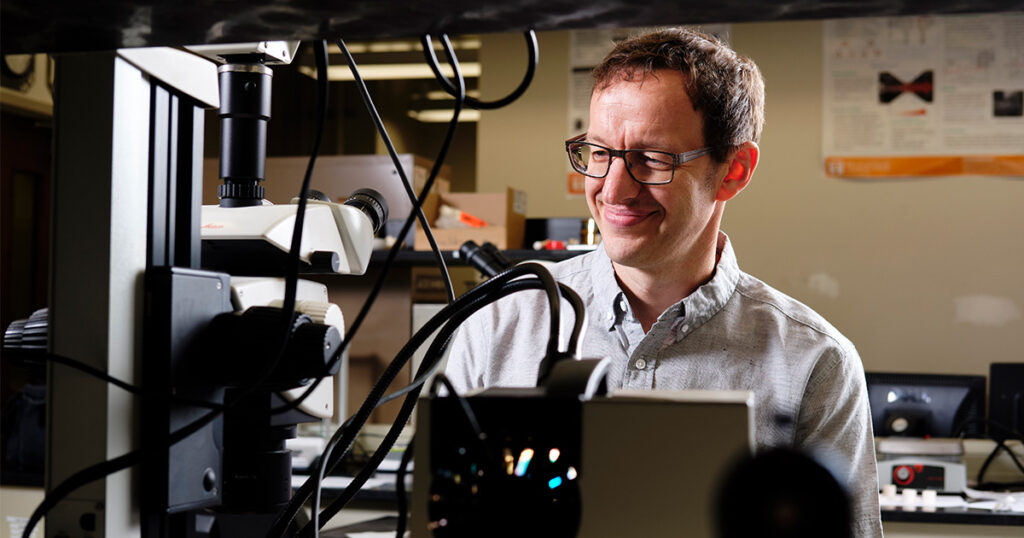In movies, blacksmiths often plunge white-hot blades into barrels of cold water. The quenching of steel produces a dramatic plume of steam—as well as a much stronger blade than the smith would get by letting the metal cool on its own.
The sudden change in temperature during quenching forcefully locks heat-induced defects into the steel’s atomic structure. Like the first frozen water molecule in a puddle, each defect forces the atoms around it to conform to the unusual arrangement. In a blink, the steel has become a metastable material: a substance that exists, but cannot form, at room temperature and pressure.
“Metastable phases often have physical properties that are desirable for diverse technological applications,” said Pietro F. Pasqua Fellow Maik Lang, a professor in UT’s Department of Nuclear Engineering. “Metastable materials are promising for next-generation electronic devices, biomedical imaging techniques, and neutron absorbers in nuclear reactors, among other uses.”
While steel is still hardened through quenching, Lang is more interested in the unusual ceramic materials produced and processed with high-energy ball milling (HEBM). Originally created to grind down powders, a ball mill consists of a rotating drum and several freely tumbling balls. Materials fed into the chaotic drum are quickly pulverized.
Decades ago, researchers also discovered that the tumbling balls of an HEBM strike with so much energy that they can chemically fuse different materials, giving rise to unconventional and complex alloys.
“The interactions in an HEBM create highly transient pressure and temperature conditions that not only trigger structural changes, but also induce a high density of defects into the material,” Lang explained. “That allows us to recover some phases from a mill at ambient conditions that we can’t recover from conventional high-pressure and high-temperature experiments.”
Unfortunately, while the HEBM can create novel metastable materials, the conditions that lead to their formation are so transient that they can’t be directly measured, let alone controlled.
“Currently, the milling process is a bit like a black box,” Lang said. “To use HEBM to its full potential, the underlying conditions that are created within a sample during the milling process must be fully understood.”
Lang and his team have plenty of experience analyzing the structures of defective materials with cutting-edge equipment, including the world’s most advanced pulsed neutron research facility, the Spallation Neutron Source (SNS) located at Oak Ridge National Laboratory (ORNL). Recently, Lang’s lab has been focused on developing new experimental strategies to characterize the atomic-scale processes that occur in materials undergoing radiation damage.
In August of 2023, with a $500,000 grant from the US Department of Energy’s Basic Energy Sciences, Lang also began investigating the “black box” of HEBM in collaboration with Assistant Research Professor Eric O’Quinn and Arizona State University Regents Professor Alexandra Navrotsky.
“Dr. Navrotsky is an expert in high-temperature calorimetry, an approach very complementary to our structural investigations,” Lang said. “Combined, we will obtain a much more in-depth understanding of the material phases we can produce by HEBM.”
Thanks to the grant, Lang will be able to train a UT graduate student and several undergraduates to perform milling experiments, alloying two simple oxide powders under different milling speeds, times, and sample-to-ball ratios.
Lang’s team will analyze the resulting metastable products at both atomic and material scales using X-ray and neutron scattering experiments, transmission electron microscopy, and Raman spectroscopy.
“Our students will learn the entire process,” Lang said, “from sample synthesis and processing within a mill to advanced structural characterization via the SNS and other, complementary techniques.”
Next, Lang and his colleagues will conduct analytical and computational modeling based on the characterization data, revealing the types of conditions that must arise during HEBM to allow the formation of certain metastable states.
Finally, the team will test those models by attempting to recreate the metastable phases of interest with state-of-the-art high-pressure and high-temperature experiments.
“Identifying the underlying phases and transitions that lead to a specific structure will enable much more precise synthesis and processing of materials by HEBM,” Lang said. “It may also help us adjust milling parameters to synthesize specific metastable phases with desirable properties.”
Contact
Izzie Gall (865-974-7203, egall4@utk.edu)
